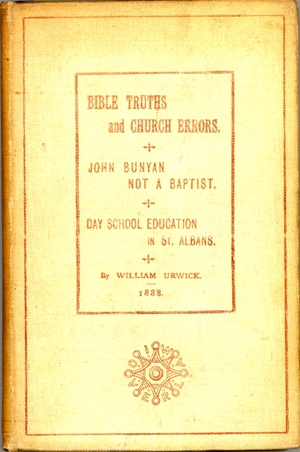|
|
Bible Truths and Church Errors John Bunyan not a Baptist Day School Education in St Albans by William Urwick Published by T Fisher Unwin, London, 1888 Hardback, 264 pages |
 |
During the 18th and 19th century many ministers published books of their sermons which now have little interest . Judged by its title it would be very easy to put this book into that category. However William Urwick was interested in history and 80 pages are of considerable interest. The relevant contents are:
Lectures upon Day School
Education in St Albans
-
The Free Grammar School
-
Dr. Clark's Charity School
-
Cross Street Infant School and the British School, Spencer Street
Index of Persons, Places and Subjects
Dr Clark's Charity School begun in 1712 and continued until about 1840, and in addition to other valuable material the book includes a letter from a former pupil part of which is as follows:
A highly esteemed member and officer of the Congregational Church here, who also is an esteemed citizen, and who has already been chosen to the office of Mayor of St. Albans, I mean, Mr. GEORGE SLADE, was a scholar in this school, and is a living witness to its good and elevating work. He has given, by my request the following account of it:-
"I was two years at the school, under Mr. WILLIAM BRANDON, 1827-1829, during which he was an invalid, suffering from gout and rheumatism. I was present at his bedside when he departed in 1829. He gave me several books, and his blessing. JAMES COLE, who was formerly master, although infirm, conducted the school for a few months, until Mr. JOHN GOODLAND was installed. Mr. Goodland came from Jamaica with the Martineau family, who had plantations in that island, and he had acted as overseer there. He was an exceedingly clever and good man, a true, devout, and practical Christian. He was famous for the beautiful models which he made of Public Buildings, places of worship, and the like, both in St. Albans and throughout the county. ...
"The Scholars attending the school came from Park Street, Colney Street, Sandridge, and the surrounding districts, as well as St. Albans. The number in the school varied from 80 to 130; the fees were 4d. to 6d. a week. We had only one week's holiday in the year, which was in harvest time. Twenty boys were clothed and educated free, and twelve girls, down to the year 1828; after then only 20 boys. Many who passed through the school became eminent mechanics. One, MILEMAN, who went to South Africa, by his mechanical skill so benefited Pietermaritzburg in Natal, that he was elected to the mayoralty twice, and is now one of the leading members of the Legislative Assembly there. JOHN GARFORTH, of Park St1eet, WILLIAM POLLARD, of Sandridge, and many others who were educated in the school, became useful and eminent men in various trades and professions. I have lost sight, during so long a lapse of time, of many who attended the school; but I know that they received a useful and sound education, one which would strengthen them to fight the battle of life here and prepare for the everlasting life hereafter. The HOLY SCRIPTURES were revered, and used in the school regularly, and the principles of plain, honest Christianity maintained. Prayer was offered, before and after the school exercises, in a simple, forcible and devout manner."
The book includes many names including a long list of subscribers to the building of the Spencer Street British School, the secretary of which was Joseph Wiles. There is a footnote to this list which fills in an important gap in the life of one of my relatives - and shows how sometime valuable information can turn up in the most unlikely places.
Mr. RICHARD GIBBS, Printer and Bookseller, was born at Aylesbury, May 4, 1804, was apprenticed to William Baxter, a printer at Oxford, and came to St. Albans in the year 1826. He lived with his brother in the old picturesque cottage-like house, now pulled down, which abutted on the Clock Tower in the Market Place. He took the Old Moot Hall for his business on Dec. 14th, 1837, the premises still occupied by the firm. He was for many years a member of the Congregationa1 Church, and afterwards joined the Baptist Church, Dagnal Street, where he was chosen Deacon. He was highly respected as a citizen, and was a warm supporter of education. He died in November, 1883. The present Mayor of St. Albans is his son.
Richard Gibbs founded the Herts Advertiser, and was brother to my great-great-grandfather, John Gibbs. Previously it had only been assumed that he worked in the house at the base of the Clock Tower and nothing was known about his apprenticeship.
There are web pages for St Albans and for St Albans Schools
| Locating
Books At the time this page was last updated second hand copies were available online |
Page created July 2007


